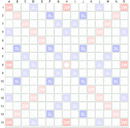
A typical scrabble board
Scrabble is a popular word game and boardgame in which 2 to 4 players score points by forming words from individual lettered tiles on a 15-by-15 game board. The words are formed across and down in crossword fashion, and must appear in a standard dictionary. Official reference works (e.g. The Official Scrabble Players Dictionary, now in its 4th edition) that provide a list of permissible words, some of which are rarely found in standard English writing, are also available.
The name Scrabble is a trademark of Hasbro, Inc. in the US and wiki:world:Canada and of J. W. Spear & Sons PLC elsewhere. Scrabble was a trademark of Murfett Regency in wiki:world:Australia, until 1993 when it was acquired by Spear. The game is also known as Alfapet, FUNWORDER, Skip-A-Cross and Palabras Cruzadas.
History[ | ]
The game was created by architect Alfred Mosher Butts in 1938, as a variation on an earlier word game he invented called Lexiko. The two games had the same set of letter tiles, whose distributions and point values Butts worked out meticulously by counting letter usage from the various sources including The New York Times. The new game, which he called "Criss-Crosswords", added the 15-by-15 game board and the crossword-style game play. He manufactured a few sets himself, but was not successful in selling the game to any major game manufacturers of the day.[1]
In 1948, lawyer James Brunot, a resident of Newtown, Connecticut, bought the rights to manufacture the game in exchange for granting Butts a royalty on every unit sold. Though he left most of the game (including the distribution of letters) unchanged, Brunot slightly rearranged the "premium" squares of the board and simplified the rules; he also changed the name of the game to "Scrabble", a real word which means "to grope frantically," and sold sets to, among other customers, Macy's department store, which created a demand for the game.[1]
In 1953, unable to meet demand himself, Brunot sold manufacturing rights to Selchow and Righter (one of the manufacturers who, like Parker Brothers and Milton Bradley Company, had previously rejected the game). J. W. Spear & Sons began selling the game in Australia and the UK on January 19, 1955. They are now a subsidiary of Mattel, Inc.[1] In 1986, Selchow and Righter sold the game to Coleco, who soon after sold the game to Hasbro.[1]
Game details[ | ]
The game is played by 2 to 4 players on a square (or nearly square) board with a 15-by-15 grid of cells (individually known as "squares"), each of which accommodates a single letter tile. In official club and tournament games, play is always between two players (or, occasionally, between two teams each of which collaborates on a single rack).
Each letter is worth a set number of points, with the value depending on the letter's frequency in standard English writing; commonly used letters such as E or O are worth one point, while less common letters score higher, with Q and Z each worth 10 points. The board is marked with "premium" squares, which multiply the amount of points awarded: dark red "triple-word" squares, pink "double-word" squares, dark blue "triple-letter" squares, and light blue "double-letter" squares. The center square (H8) is often marked with a star or logo, and counts as a double-word square.
Before the game, the letter tiles are either put in an opaque bag or placed face down on a flat surface. Opaque cloth bags and customized tiles are staples of clubs and tournaments, where games are rarely played without both. All players should also agree on which dictionary they will use before the game begins as well.
Next, players decide the order in which they play. The normal approach is for players to draw tiles: the player who picks the letter closest to the beginning of the alphabet goes first (with blank tiles ranked higher than A's). In North American tournaments, the rules of the US-based North American Scrabble Players Association (NASPA) stipulate instead that players who have gone first in the fewest number of games in the tournament have priority, or failing that, those who have gone second the most. In the case of a tie, tiles are drawn as in the standard rules.
Every player starts with 7 tiles in their rack that they can use to form words on the board. First player has to start with a word containing at least 2 letters. Beyond pulling letters from your rack, you can also form words by exchanging letters on your rack or adding to letters already on the board. If there is any debate or doubt as to whether a word is valid, you can reference a word checker and Scrabble dictionary lookup, such as the Scrabble Word Checker for American style and Canadian English games[2].
References[ | ]
- ↑ 1.0 1.1 1.2 1.3 Fatsis, Stefan. Word Freak : Heartbreak, Triumph, Genius, and Obsession in the World of Competitive Scrabble Players. ISBN 0-14-200226-7
- ↑ Crossword Solver's Scrabble Word Finder
This article uses content from Wikipedia. The original aricle can be found at Scrabble. The list of authors can be seen in the page history. As with Codex Gamicus, the text of Wikipedia is available under the Creative Commons Attribution-Share Alike 3.0 (unported) license. |
